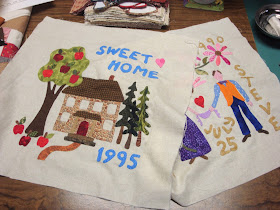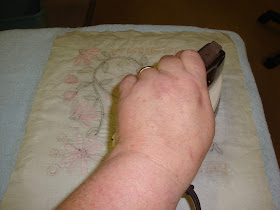Here is another "Contentment" block - this one noting the birth of our daughter. "Contentment" is a story quilt I am designing for our 20th wedding anniversary this October.
I had a long, single strand of orphan gold thread that I used to chain-stitch the delivery cap...it makes him look a little more official, doesn't it...maybe I should go back and give him a little bow tie, his skinny little neck looks so naked.
I studied a lot of pictures of storks and then tried my hand at sketching one. Remember the stork that delivered Dumbo to his sweet momma elephant? Leave it to Mr. Disney to gloss over the ordeal of birth...how many of us thought that OUR babies would be magically delivered by stork one day when we grew up?
I liked doing the feet and the knobby knees...
I'm still trying to decide how I feel about the lettering. I like the presentation of information, after all, this is a story quilt. But all that data does makes the block seem crowded...maybe I need to make the blocks 12 inches instead of 10 inches? What do you think?
All the leaves and petals are great ways to use up the tiniest scraps...and eliminates fabric decisions...they all work!
I hope you get lots of stitching done over the long, holiday weekend. I am glad I got the stork done before Labor Day, since "they" say we are not supposed to wear white AFTER Labor Day, LOL.
In stitches,
Teresa :o)

























































